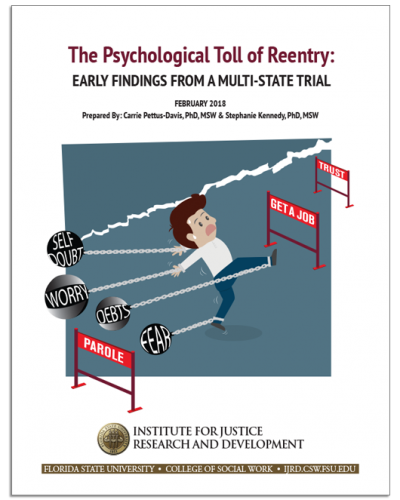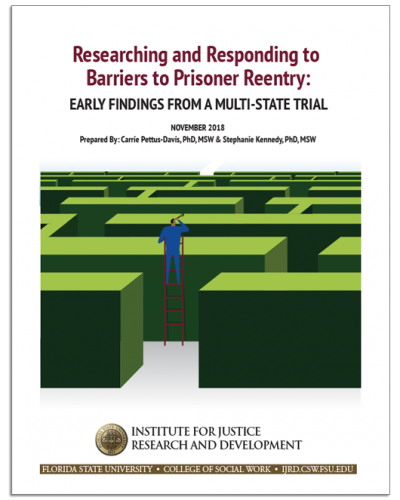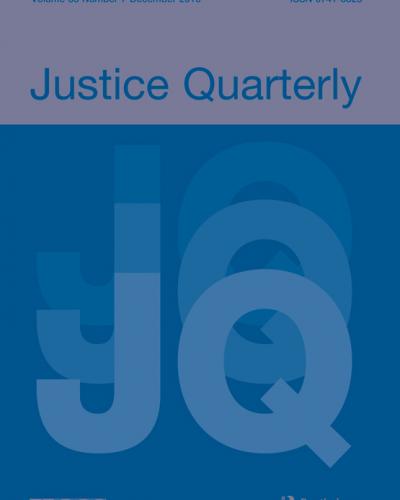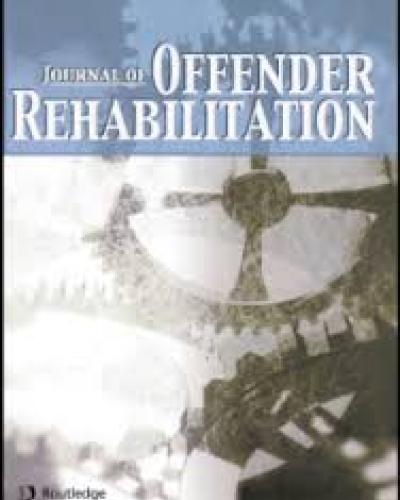
The Psychological Toll of Reentry
Published:
| Author: Carrie Pettus-Davis, Stephanie Kennedy
The struggle of reentry is common across hundreds of study participants and the reentry experience has a wide range of ripple out consequences for individual, family, and community well-being, and it intersects with the potential for future criminal behavior and public safety.
Category: Reentry, Well-Being, 5-Key Model for Reentry

Researching and Responding to Barriers to Prisoner Reentry
Published:
| Author: Carrie Pettus-Davis, Stephanie Kennedy
This report describes the inner workings and early discoveries of participants and researchers in a groundbreaking longitudinal study currently occurring in four states, 50 prisons, 12 urban and rural counties with more than 1800 people enrolled since May 2018. The study, officially titled A Multisite Randomized Controlled Trial of the 5 Key Model for Reentry, is research that is occurring as a part of a larger initiative referred to as the Safe Streets and Second Chances initiative.
Category: Reentry, Well-Being, 5-Key Model for Reentry

The Intersectional Effects of Race and Gender on Time to Reincarceration
Published:
| Author: Katie Ropes Berry, Stephanie Kennedy, Margaret Lloyd, Christopher Veeh, Stephen Tripodi
People of color are overly incarcerated and reincarcerated after release. In an 8-year analysis of more than 21,000 individuals leaving state prisons, Black men were incarcerated more often and more quickly when compared to all other groups. However, with two exceptions (age at intake and marital status), Black men had lower risk scores on most variables when compared to other members of the sample. The interactions found were a potent predictor of time to reincarceration, even when controlling for a range of identified risk factors.
Category: Reentry, Recidivism, Racial and Gender BIas

The Relationship Between Interpersonal Victimization and Women’s Criminal Sentencing: A Latent Class Analysis
Published:
| Author: Stephanie Kennedy, Annelise M. Mennicke, Megan Feely, Stephen Tripodi
Latent class analysis was used to identify subgroups of incarcerated women differentiated by experiences of child abuse and intimate partner violence victimization. Four classes were extracted—Low Victimization, Child Abuse, Lifetime Physical and Psychological Abuse, and Lifetime Sexual Abuse; classes were then related to current sentence length, holding criminological predictors constant. Women in the Child Abuse and Lifetime Sexual Abuse classes had significantly longer sentences, despite the lack of significant between-class differences on criminological predictors.
Category: Incarcerated Women, Trauma, Sentencing

Assessing Attitude and Reincarceration Outcomes Associated With In-Prison Domestic Violence Treatment Program Completion
Published:
| Author: Annelise M. Mennicke, Stephen Tripodi, Christopher Veeh, Dina Wilke, Stephanie Kennedy
Studies indicate that as many as 30%–56% of incarcerated men have perpetrated domestic violence, and that factors related to domestic violence perpetration are associated with long-term recidivism after release. The current study evaluates the effectiveness of an in-prison domestic violence treatment program called STOP and Change Direction to increase positive attitudes toward women, decrease levels of criminal thinking, and reduce general recidivism rates for program completers.
Category: Trauma, In-Prison Intervention
Examining Dose–Response Relationships Between Childhood Victimization, Depression, Symptoms of Psychosis, and Substance Misuse for Incarcerated Women
Published:
| Author: Stephanie Kennedy, Stephen Tripodi, Carrie Pettus-Davis, Jaime Ayers
The current study uses the dose–response model to examine the relationships between childhood victimization events and subsequent depression, symptoms of psychosis, and substance misuse in a sample of 230 randomly selected incarcerated women in the United States. Results on the frequency of victimization were mixed. In this sample, both frequency of physical abuse and frequency of sexual abuse significantly predicted current symptoms of psychosis, but only frequency of physical abuse significantly predicted substance misuse.
Category: Trauma, Mental Health, Substance Use

The relationship between childhood abuse and psychosis for women prisoners: Assessing the importance of frequency and type of victimization.
Published:
| Author: Stephanie Kennedy, Stephen Tripodi, Carrie Pettus-Davis
This study examines the relationship between childhood victimization and self-reported current symptoms of psychosis in an incarcerated female population in the United States. Participants are 159 randomly selected women incarcerated in two North Carolina state prisons. Participants completed a battery of self-report measures to assess childhood victimization and current and lifetime experience of audio/visual hallucinations and delusions.

